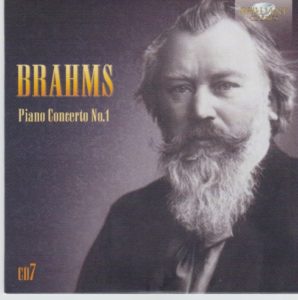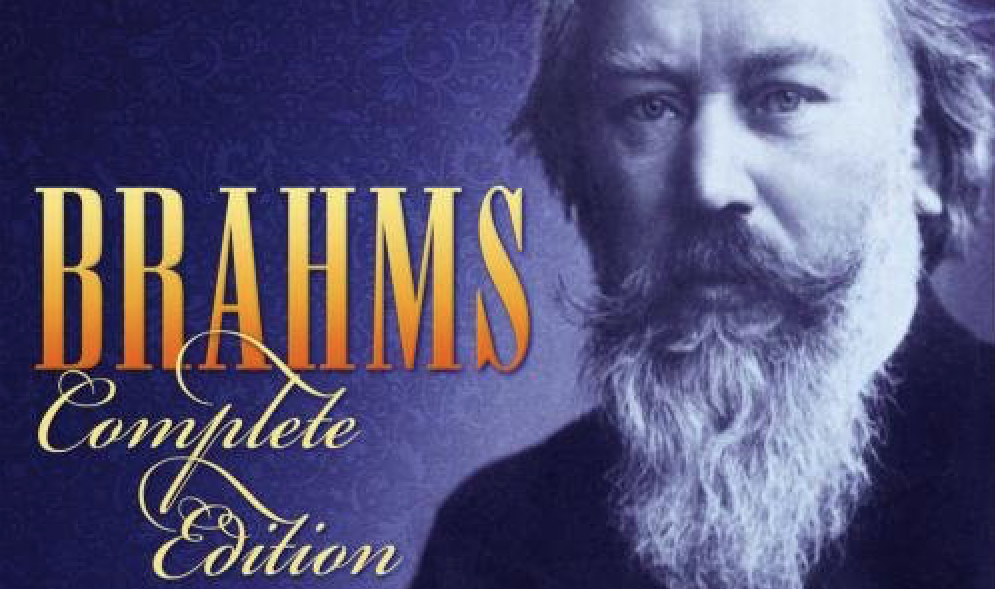
This morning, I’m listening to Daniel Barenboim – who’s known more for conducting these days than for his piano virtuosity – perform Brahms’ Piano Concerto No. 1 in D minor. The conductor is Sir John Barbirolli (1899-1970). The orchestra is the New Philharmonia Orchestra.
I probably listened to this CD 7-8 times today as I worked on a another project of mine. I found it to be, well, I’ll save my opinion for the end of today’s blog entry.
For now, just the facts.
From its entry on Wikipedia, I learned
The Piano Concerto No. 1 in D minor, Op. 15, is a work for piano and orchestra completed by Johannes Brahms in 1858. The composer gave the work’s public debut in Hanover the following year. It was his first-performed orchestral work, and (in its third performance) his first orchestral work performed to audience approval.
From the Wikipedia section titled Biographical Points,
Brahms’s biographers often note that the first sketches for the dramatic opening movement followed quickly on the heels of the 1854 suicide attempt of the composer’s dear friend and mentor, Robert Schumann, an event which caused great anguish for Brahms. He finally completed the concerto two years after Schumann’s death in 1856.
The degree to which Brahms’s personal experience is embedded in the concerto is hard to gauge since several other factors also influenced the musical expression of the piece. The epic mood links the work explicitly to the tradition of the Beethoven symphony that Brahms sought to emulate. The finale of the concerto, for example, is clearly modeled on the last movement of Beethoven’s Piano Concerto No. 3, while the concerto’s key of D minor is the same as both Beethoven’s Symphony No. 9 and Mozart’s dramatic Piano Concerto. No. 20.
I find stuff like that fascinating, as well as the fact that Brahms was only 25 when he composed Piano Concerto No. 1 in D minor. Twenty five! I don’t remember what I was doing when I was 25. But I’m quite certain I didn’t have the wherewithal to write a piano concerto – in D minor or any other key.
From its entry in the Form section of Wikipedia,
This concerto is written in the traditional three movements and is approximately 40 to 50 minutes long.
Maestoso (D minor) The first movement is in sonata form, divided into five sections: orchestral introduction, exposition, development, recapitulation, and coda. This movement is large, lasting between 20 and 25 minutes. Although without a cadenza, the strict adherence to forms used in the Classical Period earned Brahms a reputation for being musically “conservative”, but his innovative harmonies and chord-progressions were hardly that. The theme heavily makes use of arpeggiated chords and trills. Within the orchestral introduction other themes are introduced, and the thematic material is further developed by both orchestra and soloist.
Adagio (D major) This movement is in a ternary form, with the theme being introduced by bassoons.
Rondo: Allegro non troppo (D minor → D major) The structure of the Rondo finale is similar to that of the rondo of Beethoven’s Piano Concerto No. 3. There are three themes present in this rondo; the second theme may be considered a strong variation of the first. The third theme is introduced in the episode but is never explicitly developed by the soloist, instead the soloist is “integrated into the orchestral effect”. A cadenza follows the bulk of the rondo, with an extensive coda that develops the first and third themes appearing afterward. The coda is in the parallel major, D major.
My Rating:
Recording quality: 5 (superb, no complaints, crystal clear)
Overall musicianship: 5 (remarkable)
CD liner notes: 3 (11-page essay about the life of Brahms, little else)
How does this make me feel: 5 (loved it!)
I’ve seen Daniel Barenboim in person. It was at Carnegie Hall on Saturday, January 28, 2017. He conducted Bruckner’s 8th Symphony. Staatskapelle Berlin supplied the music. The encore applause, alone, lasted 15 minutes.
I knew Barenboim was a pianist. But I didn’t know until I heard him perform Brahms’ Piano Concerto No. 1 in D minor how good he was (and maybe still is, I don’t know).
Barenboim was fantastic in this recording, which – by the way – was superb as well. For a recording a half century old, this was delightfully crisp with full tonality.
Two thumbs way up!
If you’d like to know what Brahms’ Symphony No. 1 in D minor sounds like, here’s a recording of Arthur Rubinstein on the piano, the Concertgebouw Orchestra, and Bernard Haitink conducting. It’s a dream line-up.
Enjoy!
